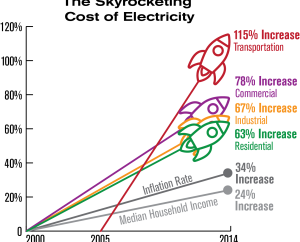As transport and warming become more environmentally well disposed of, the ecological impact of energy utilization will not be set in stone by power. The Global Energy Organization expects modifications of endowments for petroleum products which added up to $550 billion in 2013, multiple times environmentally friendly Electricity Rates appropriations. In this situation, close to half of the expansion in 2040 power utilization is covered by over 80% development in sustainable power. Numerous new atomic plants will be developed, fundamentally to supplant old ones. The atomic piece of power age will increment from 11 to 12%. The inexhaustible part goes up substantially more, from 21 to 33%.
The IEA cautions that to limit a worldwide temperature alteration to 2 °C, carbon dioxide outflows should not surpass 1000 gigaton (Gt) from 2014. This cutoff is reached in 2040 and emanations won’t drop to zero of all time. The World Energy Board sees world power utilization expanding to in excess of 40,000 TWh/an every 2040. The fossil piece of age relies upon energy strategy. It can remain around 70% in the alleged Jazz situation where nations rather freely “make do” yet it can likewise diminish to around 40% in the Ensemble situation assuming nations work “arranged” for a more environment cordial strategy.

In OCDE Energy utilization
In 2019, OECD’s last power utilization was 9,672 TWh. The modern area consumed 41.9% of the power, the private area consumed 26.6%, the business and public administration areas consumed 21.2%, the vehicle area consumed 1.8%, and different areas (e.g., horticulture and fishing) consumed 8.5%. In ongoing many years, utilization in the private and business, and public administration areas has developed, while industry utilization has declined. All the more as of late, the vehicle area has seen an expansion in utilization with the development in the electric vehicle market.
Utilization per capita
Last utilization isolated by the number of occupants gives a country’s utilization for every capita. In Western Europe, this is somewhere in the range of 4 and 8 MWh/a. (1 MWh approaches 1000 kWh.) In Scandinavia, the USA, Canada, Taiwan, and South Korea, per capita utilization is higher, in any case, in emerging nations, it is a lot lower. The world’s normal is almost 3 MWh/a. An extremely low utilization level, as in Indonesia, demonstrates that numerous occupants are not associated with the power framework, and that is the explanation that a portion of the world’s most crowded nations, like Nigeria and Bangladesh, don’t show up in the table.
World Energy Utilization
- In 2019, the complete overall power creation was almost 27,044 TWh. Complete essential energy is changed over into various structures, including, yet not restricted to, power, intensity, and flammable gas. Essential energy is lost during the change of power, as found in the US, where 61% was lost in 2019. Power represented 19.7% of overall last energy utilization in 2019, while oil was 40.4%, coal was 9.5%, gaseous petrol was 16.4%, biofuels and squander were 10.4%, and different sources were 3.6%.
- The absolute last power utilization in 2019 was divided unevenly between the accompanying areas: industry, private, business, public administration, transport, and others. Starting around 1973, last power utilization has diminished in the modern and transport areas and expanded in the private, business, and public administration areas.
- A responsiveness examination on a versatile neuro-fluffy organization model for electric interest assessment shows that work is the most basic variable impacting electrical utilization. The review involved six boundaries as information, business, Gross domestic product, abiding, populace, warming degree day, and cooling degree day, with power interest as the result variable.
